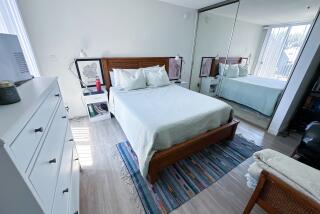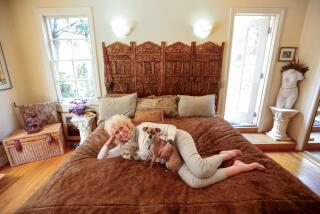Design : ‘We Live in Our Bathroom’
- Share via
After an exhausting work week, Lori Graham and husband Michael Bunney like to uncork the champagne, bring out the munchies and spend Friday night at home. But the two-career couple doesn’t watch TV in the den or curl up beside the living room fireplace. Their destination: the bathroom.
Graham and Bunney, who live in Del Mar, don’t have an ordinary commode. Their second-story master bath--with a whirlpool tub for two that overlooks the Pacific and the race track--is part of one big room that extends from bathroom to bedroom to sitting room without a wall in between.
This sprawling, sybaritic sanctuary, which constitutes the couple’s entire 1,000-square-foot second floor, opens onto an outdoor ocean-view deck and includes a fireplace in the sitting room and a “mini-kitchen” with a microwave oven, a refrigerator and a coffee maker.
“We live in our bathroom,” says Graham, who created the roost with fellow designer William Peterson. “On Fridays after a hard week, Mike and I often come upstairs, open a bottle of champagne, use the whirlpool and do a little grazing on cheese and crackers,” said Graham, who’s in charge of Palomar College’s design program. “We literally spend almost the whole evening up there . . . just the two of us.”
Not everyone can boast a loo as lush as Graham’s and Bunney’s. But the bathroom, often an embarrassed afterthought in home design, has gained greater status. Today, more people are putting more thought and money into their bathrooms, designing lavatories more luxurious and individualized than ever, and, as Peterson says, that function as areas of “recreation as well as sanitation.”
“The bathroom is no longer a utility room only,” Peterson said at a recent UCLA symposium on bath and kitchen design. “It’s now a retirement location and relaxation suite.”
Bathrooms are “more openly enjoyed than they ever were by our puritanical ancestors,” said UCLA symposium speaker John Laughton, manager of marketing projects for American Standard, the bathroom product manufacturer. “There is no doubt that Californians and their interior designers have led the way into bringing the bathroom out into the open in recent times. Indeed, throughout the Western World, interior designers and architects are today focusing considerable attention on the bathroom, and I think it’s become the hottest room in the house.”
The new emphasis on the bathroom is largely due to womens’ new prominence in the work place, said Peterson in an interview. “The amount of time two working professionals spend together is limited, and they want to make it quality time. And rather than sit in front of the boob tube, they go where they can relax and talk.”
Others attribute the phenomenon to cocooning--spending leisure time at home--and the rise in construction costs.
Elsa and Peter Myers aren’t spending more time in their bathroom. But they had designer Nick Berman create a bathroom that was hardly an afterthought to the rest of their home, built in 1971 by renowned California ranch-home designer Cliff May and entirely remodeled by Berman in South western styles.
The Myers live on a Pacific Palisades hillside that gives them a 180-degree ocean view, stretching from the Santa Monica Mountains on the North to downtown Los Angeles on the southeast.
Their tunnel-shaped bathroom--with a 29-foot-long skylight, a travertine floor that seamlessly sweeps up to form a travertine whirlpool tub, and exposed, sand-blasted beams and textured plaster walls and ceiling--assumes the same serene, understated elegance as the rest of their abode.
Luna Cream granite used for twin bathroom sinks matches kitchen counter tops; rift oak cabinets in the bathroom are repeated in the den and bedroom; and pewter bathroom faucets match doorknobs and other fixtures in and outside the house. Natural light filters through ubiquitous windows and glass doors.
“Meticulous detailing” throughout the house, such as the glass bricks surrounding the Myers’ custom-designed tub and medicine cabinets built flush with the wall mirrors that conceal them, exemplify the care with which Berman designed this bathroom.
“I don’t know if people are spending more time in their bathrooms,” says Berman, who has had his own local design firm for 10 years, “but they are definitely spending more money” creating the room.
The proliferation of new bath products and increased sales emphasize the bathroom’s new status.
“In the old days, you’d slap down $35 for a faucet,” says Sidney Altman, who owns a bath product store in West Hollywood. “Now it’s like clothes and cars . . . people are into buying the best they can afford.”
Business is booming, says Altman, also one of the industry’s most progressive designers. Indeed, within the last two years, nine new bathroom fixture shops have opened on Beverly and Robertson boulevards and Melrose Avenue in West Hollywood, he says.
Among the most popular products in today’s bathroom are the whirlpool tubs for two, now standard in higher-level homes, industry experts say. And, while the bidet is still more a European custom, it has also become more commonplace in this country. “If people have the space, they stick it in automatically,” says Altman.
Convenient mini-kitchens, like the Graham/Bunney’s, are “quite common in better homes today,” says Peterson, as are exercise equipment and the space sectioned off in the bathroom for its use.
Other bathroom trends: Pedestal sinks, which have proliferated in bathroom product showrooms and catalogues, and one-piece toilets, with their tank contained in the same sculpted, streamlined shape as their bowl.
“Rainbars”--two-foot-long bars hung vertically in the shower--that spray water below the neck to keep bathers’ hair dry, are also big sellers, says Altman, as are “waterfall spouts.” These fill the tub with water that cascades from uniquely-shaped faucets.
Altman designed a stepped waterfall spout for a bathroom in businessman David Reiss’ Marina Del Rey condominium designed by Pat Schultz, head of Placing and Spacing Interiors. This fixture spills a 16-inch sheet of water into Reiss’ whirlpool tub. It is decorated with faux lapis , its metal base painted with an acrylic lacquer to look like deep blue lapis lazuli.
(Altman creates other hot-selling faux sink and bath fixtures designed to look like malachite, travertine and rhondonite, he says, and other innovative faucets, such as one that resembles a Piaget watch band, and a C-shaped concave die-cast sink faucet.)
Like the Myers’ bathroom, not a single ceramic tile can be found in Reiss’ bathroom: black Martina Negra marble covers the floor and complements the black and gray granite used elsewhere in the beach-front home.
Indeed, “Marble and granite are king,” Altman says, and experts agree that the natural stones are here to stay, whether used as they are increasingly in residential bathrooms or, as any Los Angeles resident can see, for high-rises and other commercial properties.
In addition to the durability, low maintenance and timelessness of natural stones, it’s nearly impossible to find two stones alike and a great variety of color of stone exists, thus the material can reflect a homeowner’s individual taste and style, says Walter Iberti, assistant vice president of Walker & Zanger Ltd., a marble and granite distribution firm.
Also, recent technological advances used to quarry, cut and polish stones have lowered their cost and thus increased their residential use, said Iberti, another speaker at the recent UCLA symposium.
However, ceramic tile isn’t passe. Italian tile designers--the consistent leaders in the field--continue to create innovative products.
The most recent developments in Italian tile design emerged here this May at the first annual World Exposition of Ceramic Tile and Bathroom Furnishings at the Los Angeles Convention Center.
No longer limited to pastels and neutrals, Italian designers showed up with a new variety in tile color--bright red, blue, purple, green and yellow. They also displayed a greater variety of tile size--from 1/2-inch by 4-inch pieces to those 20-inch by 20-inch--and tiles with distinctive surface textures, such as those called “Glass” with a crackled effect.
Last fall’s fourth annual Cersaie, the world’s largest international exposition of ceramic tile and bathroom products held in Bologna, Italy, also brought forward such new trends as faux tiles fashioned to look like slate, marble, granite, quartz, terra cotta and wood. Bordered tiles and tiles in bold neutral tones, black, gray and white, were also popular.






